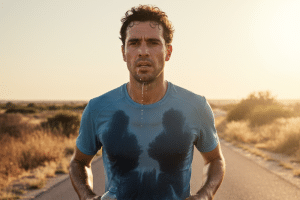 As the summer sun blazes down, many runners find themselves facing the challenge of maintaining their training routines in extreme heat. While running is a fantastic way to stay fit, the risks associated with high temperatures can be significant. Understanding how heat affects the body, recognizing the signs of heat-related illnesses, and implementing effective strategies for safe running in hot weather are essential for every runner. This guide will explore these aspects in detail, providing you with the knowledge to navigate your runs safely during the sweltering months.
As the summer sun blazes down, many runners find themselves facing the challenge of maintaining their training routines in extreme heat. While running is a fantastic way to stay fit, the risks associated with high temperatures can be significant. Understanding how heat affects the body, recognizing the signs of heat-related illnesses, and implementing effective strategies for safe running in hot weather are essential for every runner. This guide will explore these aspects in detail, providing you with the knowledge to navigate your runs safely during the sweltering months.
Understanding the Risks of Running in Heat
Running in high temperatures can lead to various heat-related illnesses, primarily due to the body’s inability to regulate its core temperature effectively. When the temperature rises, the body generates heat through physical exertion, and the natural cooling mechanism—sweating—may become insufficient, especially in humid conditions.
Heat-Related Illnesses
-
- Heat Exhaustion: This condition occurs when the body loses excessive fluids and electrolytes through sweating. Symptoms include heavy sweating, weakness, dizziness, nausea, and headaches. If not addressed promptly, heat exhaustion can escalate into more severe conditions.
- Heat Stroke: This is a life-threatening emergency characterized by a body temperature exceeding 104°F (40°C). Symptoms may include confusion, seizures, and loss of consciousness. Immediate medical attention is crucial, as prolonged heat stroke can lead to organ damage or death.
Factors Influencing Heat Tolerance
Several factors can affect how well an individual tolerates heat, including:
-
- Acclimatization: Runners who gradually expose themselves to higher temperatures over a period of 7-14 days can adapt better. This process enhances the body’s ability to sweat and improves cardiovascular efficiency.
- Hydration Levels: Proper hydration is vital. Dehydration can impair the body’s ability to cool itself, increasing the risk of heat-related illnesses.
- Clothing Choices: Wearing appropriate clothing can significantly impact heat retention. Lightweight, moisture-wicking fabrics are preferable to heavy, dark materials.
Recognizing the Signs of Heat Illness
Being aware of the symptoms of heat-related illnesses is crucial for any runner. Early recognition can prevent serious complications.
Symptoms to Watch For
-
- Heat Exhaustion:
- Heavy sweating
- Weakness or fatigue
- Dizziness or fainting
- Nausea or vomiting
- Headaches
- Heat Stroke:
- High body temperature (104°F or higher)
- Altered mental state (confusion, agitation)
- Hot, dry skin or profuse sweating
- Rapid pulse
- Loss of consciousness
- Heat Exhaustion:
What to Do If Symptoms Occur
If you or a fellow runner experiences any of these symptoms, it’s essential to take immediate action:
-
- Stop Running: Find a shaded area or a cool place to rest.
- Hydrate: Drink cool water or an electrolyte-replenishing beverage.
- Cool Down: Use cold towels, ice packs, or immerse in cool water if possible.
- Seek Medical Help: If symptoms persist or worsen, call for medical assistance.
Preparing for Hot Weather Runs
Preparation is key to safely running in extreme heat. Here are some strategies to help you get ready:
Hydration Strategies
-
- Pre-Hydrate: Aim to drink water throughout the day leading up to your run. The American College of Sports Medicine recommends consuming 16-20 ounces of water at least four hours before exercising.
- During the Run: For runs lasting longer than an hour, consider sipping 3-8 ounces of water every 15-20 minutes. If you’re running for over an hour, electrolyte drinks can help replenish lost minerals.
- Post-Run Rehydration: After your run, drink at least 16-24 ounces of fluid for every pound lost during exercise. Weighing yourself before and after can help gauge fluid loss.
Choosing the Right Time to Run
Timing your runs can significantly impact your safety. The sun is typically at its peak between 10 a.m. and 6 p.m., making these hours the hottest. Consider the following:
-
- Early Morning or Late Evening: These times usually offer cooler temperatures and less intense sunlight.
- Avoiding Direct Sunlight: Seek shaded routes or run in areas with tree cover to minimize sun exposure.
Clothing and Gear for Hot Weather
What you wear while running can make a significant difference in your comfort and safety during hot weather.
Clothing Choices
-
- Lightweight Fabrics: Opt for breathable, moisture-wicking materials that allow sweat to evaporate quickly.
- Light Colors: Light-colored clothing reflects sunlight, helping to keep your body cooler.
- Avoid Cotton: Cotton absorbs moisture and can become heavy and uncomfortable when wet.
Accessories
-
- Hats and Sunglasses: A wide-brimmed hat can shield your face from the sun, while UV-protective sunglasses can protect your eyes.
- Sunscreen: Apply a waterproof sunscreen with at least SPF 30 to protect your skin from harmful UV rays.
Adjusting Your Running Pace
When running in extreme heat, it’s essential to adjust your expectations and pace.
Slowing Down
-
- Listen to Your Body: Your body will naturally signal when it’s working too hard. If you feel fatigued or overheated, slow down or take walking breaks.
- Use the Talk Test: If you can’t maintain a conversation while running, it may be time to ease up on your pace.
Heat Adjustment Calculator
Utilizing tools like a heat adjustment calculator can help you set realistic goals based on the temperature and humidity. This can guide you in adjusting your expected finish times for races or training runs.
Cooling Techniques During Runs
Implementing cooling strategies during your run can help maintain a safe body temperature.
Hydration and Cooling
-
- Carry Water: Always bring water with you, even on shorter runs. Hydration packs or handheld bottles can be convenient.
- Douse Yourself: Pouring water over your head or body can help cool you down. Running through sprinklers or using ice packs can also be effective.
Finding Shade
-
- Route Planning: Choose routes that offer shade or run near bodies of water, which can provide a cooler environment.
- Short Loops: Consider running shorter loops that allow you to return to a cooler area or access water frequently.
Post-Run Recovery
Cooling down after your run is just as important as preparation.
Immediate Actions
-
- Cool Down: After finishing your run, take time to cool down gradually. Use cold towels or take a cool shower to lower your body temperature.
- Rehydrate: Drink plenty of fluids to replenish what you lost during your run.
Monitoring Recovery
-
- Rest and Recovery: Allow your body adequate time to recover, especially after running in extreme heat. This may involve additional rest days or lighter workouts.
- Watch for Symptoms: Be vigilant for any signs of heat-related illness in the hours following your run.
The Importance of Acclimatization
Acclimatization is the process by which your body adapts to heat over time. This is crucial for runners who wish to maintain their performance during hot weather.
How Acclimatization Works
-
- Increased Sweat Rate: As you acclimatize, your body becomes more efficient at sweating, which helps cool you down.
- Improved Cardiovascular Function: Your heart becomes more efficient, allowing for better blood flow and temperature regulation.
Tips for Acclimatization
-
- Gradual Exposure: Start with shorter runs in the heat and gradually increase duration and intensity over 1-2 weeks.
- Stay Consistent: Regularly running in warm conditions will help your body adapt more effectively.
Recognizing Vulnerable Populations
Certain groups may be more susceptible to heat-related illnesses, and it’s essential to be aware of these vulnerabilities.
At-Risk Individuals
-
- Older Adults: Age can affect the body’s ability to regulate temperature and respond to heat.
- Children: Young children may not recognize their need for hydration or breaks, making them more vulnerable.
- Individuals with Medical Conditions: Those with heart or respiratory issues may face additional risks when exercising in the heat.
Strategies for Vulnerable Groups
-
- Supervision: Ensure that children and older adults are monitored during outdoor activities in hot weather.
- Education: Teach them about the importance of hydration and recognizing heat-related symptoms.
Running in extreme heat presents unique challenges, but with the right knowledge and preparation, you can enjoy your runs safely. By understanding the risks, recognizing symptoms of heat-related illnesses, and implementing effective strategies for hydration, pacing, and acclimatization, you can continue to pursue your running goals even in the hottest months. Always listen to your body, adjust your expectations, and prioritize your health above all else. With these precautions in mind, you can make the most of your summer running experience while staying safe and healthy.
The Brain Cooler Helps Protect Athletes Who Play Outdoors in the Heat
Safeguarding an athlete’s cranial health is paramount when playing contact sports where there is a risk of head injuries. The Brain Protector provides protection from contact and heat.
> Buy Now
Contact Us for More Information
Buy Now
—
 About Brain Cooler
About Brain Cooler
Safeguarding an athlete’s cranial health is paramount when playing contact sports where there is a risk of head injuries. The Brain Protector provides protection from contact and heat.
> Learn More
> Buy Now

 About Brain Cooler
About Brain Cooler